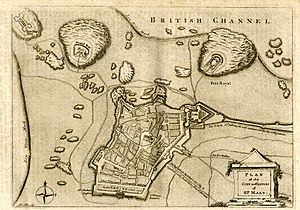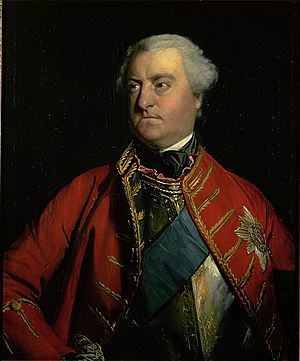Raid on St Malo facts for kids
Quick facts for kids Raid on St Malo |
|||||||
|---|---|---|---|---|---|---|---|
| Part of Seven Years' War | |||||||
 Map of Saint Malo |
|||||||
|
|||||||
| Belligerents | |||||||
| Commanders and leaders | |||||||
| Strength | |||||||
| 13,000 22 Ships of the line 8 Frigates |
|||||||
| Casualties and losses | |||||||
| light | 30 Privateers & 100 vessels burned | ||||||
The Raid on St Malo happened in June 1758. A British naval force, along with soldiers, landed near the French port of St Malo in Brittany. This was an amphibious attack, meaning it involved both ships and land troops.
The British did not attack the town of St Malo itself, even though that was the first plan. Instead, they destroyed many French ships. After about a week, the British forces left. The navy was led by Richard Howe, and the army by the Duke of Marlborough and Lord Sackville.
Contents
Why the British Raided St Malo
The British wanted to help their allies in Germany during the Seven Years' War. William Pitt, a key British leader, thought of a plan. He wanted to launch "naval descents," which were surprise attacks from the sea onto the French coast.
In 1757, a large group was sent to Rochefort, France. They captured an island nearby but failed to attack the town itself. Pitt believed this failure was because the commanders were not bold enough. So, he planned more attacks for the next year.
The Attack on St Malo

By early 1758, the British government planned the next raid. They started gathering their forces on the Isle of Wight. Pitt had learned important lessons from the Rochefort mission. New landing boats were designed to make it easier to get soldiers ashore. The process of getting the force ready was also made faster.
The target chosen was St Malo. This port in northern Brittany was known for fishing and for its privateers. Privateers were private ships allowed by the government to attack enemy ships. St Malo was a good target because it was close to the English Channel. This meant the British force could quickly return home if France tried to invade Britain.
Landing and Destruction
On June 1, the British expedition sailed from England. They reached Cancale Bay, near St Malo, on June 5. That evening, the landing boats brought the soldiers ashore. St Malo was located at the end of a long, narrow path called a causeway. The British hoped to cut off the town's fresh water supply, which ran along this causeway.
The only immediate resistance came from a French artillery battery. But the British frigates fired back, silencing the enemy's guns. The troops then landed without any more trouble.
The soldiers marched towards St Malo. However, it quickly became clear that taking the town would require a full siege. A siege is when an army surrounds a place and tries to capture it slowly. The British did not have enough time for a long siege.
Instead, the British occupied St Servan, a nearby port. There, they burned 30 privateer ships and 100 other vessels. This caused a lot of damage to the French navy.
British Withdrawal
British troops were sent to scout east towards Dol. They reported that a large French force was approaching. Because of this, the Duke of Marlborough decided it was time to leave. On June 11 and 12, the British expedition got back onto their ships.
The force stayed near St Malo for over a week. They then sailed along the coast, looking for new targets. They thought about attacking Le Havre or Caen but decided against it. The British then focused on Cherbourg in Normandy. However, bad weather stopped their planned landings on June 29 and July 3.
With his troops running low on water and supplies, Marlborough decided to return home. The expedition sailed back to Portsmouth.
What Happened Next
Even though the British did not capture St Malo, the raid was seen as a success. When the expedition first set off, the French were worried. They thought the British were heading to Flanders to join the German army. When they found out St Malo was the target, the French were actually relieved.
However, just like with the Rochefort raid, this sudden attack made the French more concerned about their coast. They started sending more and more troops to defend their coastal areas.
In September of the same year, after a successful raid on Cherbourg, another British force tried to attack St Malo again. This time, they were caught on shore by a larger French army. They had great difficulty getting back to their ships after the Battle of Saint Cast. This battle ended the British policy of making these coastal attacks. The British government decided to focus more on having their army directly in Germany.

